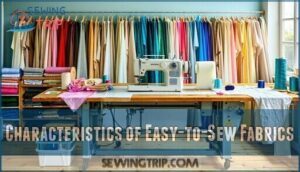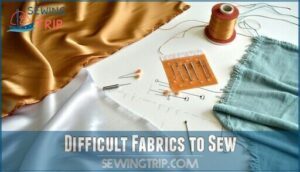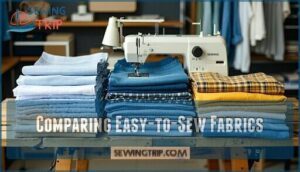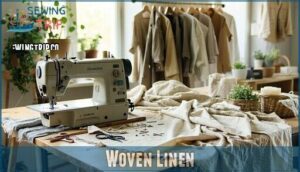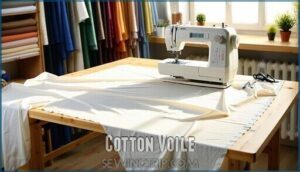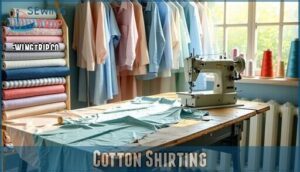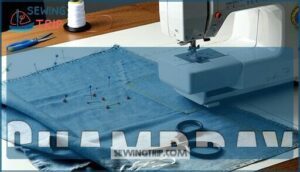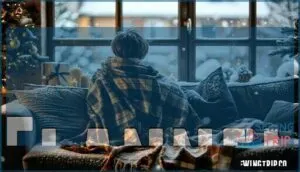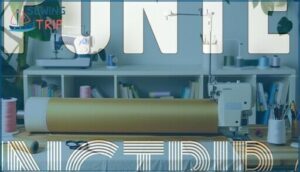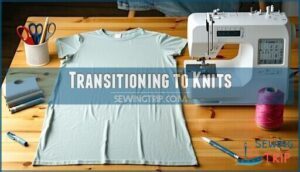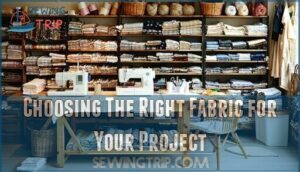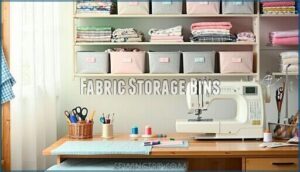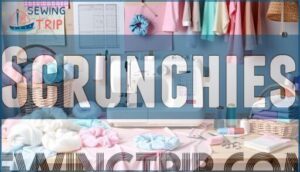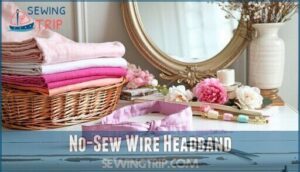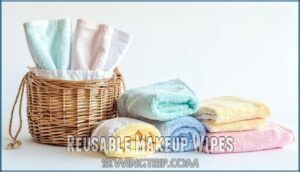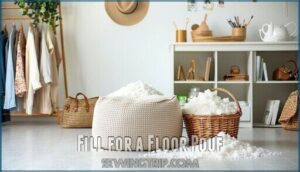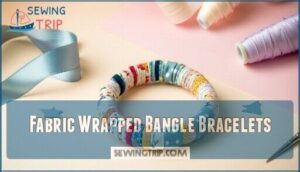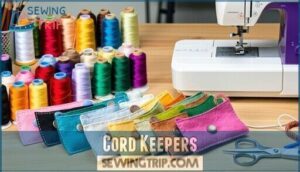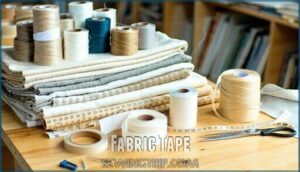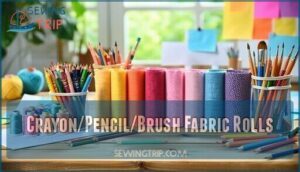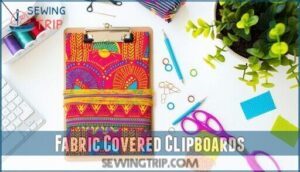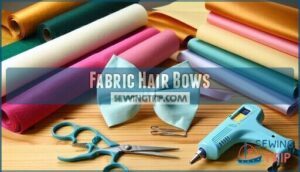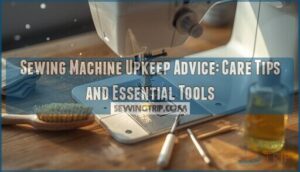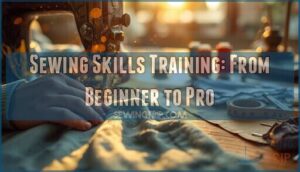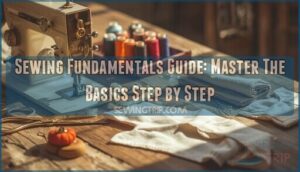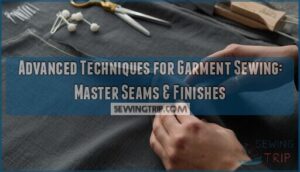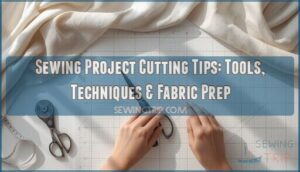This site is supported by our readers. We may earn a commission, at no cost to you, if you purchase through links.
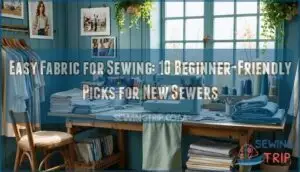
You will not fight with slipping or stretching. Cutting and pinning feel like a breeze.
Cotton and polyester are also budget-friendly so you can experiment without breaking the bank. Think of them as training wheels for your sewing journey.
You get predictable results and less frustration. Avoid slippery silk or stretchy knits at first. Stick with easy fabric for sewing and you will stitch with confidence.
Curious about project ideas?
Table Of Contents
- The Benefits of Easy Fabrics for Sewing
- Characteristics of Easy-to-Sew Fabrics
- Difficult Fabrics to Sew
- Comparing Easy-to-Sew Fabrics
- Fabrics Recommended for Beginners
- Transitioning to Knits
- Choosing The Right Fabric for Your Project
- DIY Projects Using Easy Fabrics
- Fabric Covered Clipboards
- Fabric Hair Bows
- Frequently Asked Questions (FAQs)
- Conclusion
The Benefits of Easy Fabrics for Sewing
When you choose fabrics that work with you instead of against you, every stitch becomes more enjoyable and your finished projects look better too.
The right fabric turns sewing from a struggle into pure creative joy
Easy-to-sew fabrics help beginners build confidence while saving money on costly mistakes, and this is crucial for saving money.
Better Sewing Experience
The right fabric choice transforms your sewing journey from frustrating to fulfilling.
Easy sewing fabrics like cotton and linen offer stable weaves that prevent puckering and skipped stitches.
Their moderate thickness provides excellent stitch formation without jamming your machine.
Minimal stretch means seams stay where you put them.
These beginner-friendly fabrics grip naturally during cutting and pinning.
You’ll spend less time wrestling with slippery materials and more time mastering essential sewing techniques.
Smart fabric choice sets you up for sewing success from day one, making it a crucial part of your journey to achieve fulfilling results with easy sewing fabrics.
Cost Efficiency
Cost efficiency makes easy fabrics smart choices for new sewers.
Cotton and polyester cost less than specialty materials like silk. You’ll stretch your budget planning while learning.
Here’s why affordable materials benefit beginners:
- Lower financial risk – Mistakes won’t break your fabric cost budget
- Practice without pressure – Cheap alternatives let you experiment freely
- Build skills gradually – Master techniques before investing in expensive fabrics
- More projects possible – Cost reduction means more fabric savings for multiple attempts
Beginner-friendly fabrics offer fabric ease of use without premium pricing.
Easy sewing shouldn’t empty your wallet while you’re mastering the basics.
Improved Product Quality
Better fabric selection leads to superior garment quality and increased sewing confidence.
Easy-to-sew materials respond predictably to your sewing techniques.
They hold their shape during construction and finishing touches.
Quality control becomes simpler when you’re working with stable fabrics.
These material choices eliminate common frustrations like puckering or stretching.
Your seams stay straight and professional-looking.
The improved sewing experience comes from fabrics that cooperate with your skills rather than fight against them.
You’ll notice cleaner results and smoother workflows immediately.
Characteristics of Easy-to-Sew Fabrics
When you’re learning to sew, the right fabric makes all the difference between a frustrating project and a rewarding experience.
Easy-to-sew fabrics share three key characteristics that help beginners build confidence and create professional-looking results, which is crucial for a rewarding experience.
Thickness
Fabric thickness acts as your sewing foundation. Medium-weight materials like cotton and linen avoid puckering while providing stability.
Consistent material density prevents thread tension issues and allows smoother machine feeding.
- Fabric weight: Choose moderate thickness for balanced handling and durability
- Material density: Consistent weave thickness creates even stitches and predictable results
- Thread count: Higher counts in woven fabric reduce fraying and improve edge stability
- Fabric stabilizers: Dense, stable materials minimize distortion during pinning and pressing
Stretchiness
Beyond thickness, fabric stretch plays a major role in sewing success. Minimal stretch fabrics like cotton shirting and linen offer better control during construction.
These low stretch textiles maintain their shape and don’t distort under your presser foot pressure. They are ideal for beginners because they provide a predictable sewing experience.
Stretchy textiles can be tricky for newcomers. Knit fabrics with high elastic properties tend to shift and curl during sewing. They often require stabilizers or special techniques that complicate your project.
When selecting fabric stretch levels, consider these guidelines:
- Choose fabrics with under 5% stretch for easiest handling
- Avoid high-stretch knit fabrics until you gain experience
- Test fabric stretch by pulling a small section gently
- Select ponte knits if you want stable stretch properties
- Remember that sewing elastics requires different needle types
Non-stretch woven fabrics create predictable seams and reduce frustration. They’re perfect for building confidence while you master basic techniques.
Presser Feet Compatibility
Standard presser feet work best with easy fabrics.
Your universal foot handles cotton broadcloth and linen without special adjustments.
These fabrics feed smoothly under regular foot control without puckering or stretching.
| Fabric Type | Compatible Presser Feet | Needle Selection |
|---|---|---|
| Cotton Broadcloth | Universal, Walking | Universal 80/12 |
| Linen | Universal, Even Feed | Universal 90/14 |
| Ponte Knit | Universal, Dual Feed | Ballpoint 80/12 |
| Chambray | Universal, Roller | Universal 80/12 |
Easy sewing means fewer sewing accessories needed.
Beginner sewing becomes less overwhelming when you don’t need specialty equipment.
Fabric guidance suggests choosing materials that match your current sewing supplies.
This fabric selection approach builds confidence while you master basic techniques.
Difficult Fabrics to Sew
While beginner-friendly fabrics make sewing enjoyable, some materials can turn your project into a frustrating challenge.
Slippery silks slide around your cutting table, ultra-thin chiffons require special needles, and stretchy jerseys need ballpoint needles to prevent runs.
Slipperiness
When slippery fabrics slide around your workspace, they can turn a simple sewing project into a frustrating battle.
These smooth surfaces lack the fabric texture needed for proper grip control during cutting and stitching.
Here are three ways to tackle slippery fabrics:
- Apply fabric spray starch – Creates temporary slip resistant coating that adds sewing friction
- Use pattern weights instead of pins – Prevents fabric shifting without creating holes in delicate materials
- Layer tissue paper underneath – Provides grip control while maintaining easy sewing flow
Slippery fabrics challenge beginners because they lack natural fabric grip.
Silk, satin, and polyester linings are notorious for sliding around your cutting mat.
This makes accurate cutting nearly impossible.
Your seams won’t align properly either.
The key is adding artificial texture to smooth surfaces.
Spray starch temporarily transforms slippery fabric into manageable material.
Pattern weights distribute pressure evenly without damaging delicate fibers.
Tissue paper tears away easily after stitching.
These techniques help you maintain control over low stretch and minimal stretch fabrics that want to escape your grasp.
Thinness
Thin materials like chiffon and organza present unique challenges for new sewers.
These lightweight woven fabrics require gentle handling to prevent tearing.
Sheer textiles tend to shift and pucker during stitching.
Cotton fabric in voile weight offers better stability than synthetic delicates.
When sewing delicates, use sharp needles and reduce machine tension.
Lightweight fabrics with minimal stretch prove more manageable for easy sewing projects, making them ideal for working with synthetic materials.
Special Presser Feet or Needles
Some fabrics demand specialty needles and presser feet to prevent sewing disasters.
When you’re wrestling with leather or vinyl, you’ll need heavy-duty needles that won’t snap under pressure.
Stretchy knits require ballpoint needles to slip between fibers without creating runs.
Walking feet help thick layers move evenly through your sewing machine.
Teflon feet glide over sticky materials like leather without dragging.
Jersey needles prevent skipped stitches on knits.
The right sewing notions transform tricky fabric handling into manageable sewing techniques.
Comparing Easy-to-Sew Fabrics
Why settle for guesswork when choosing your next sewing project fabric? Understanding easy-to-sew fabrics helps you make confident fabric choices that support your sewing journey.
Each beginner-friendly fabric offers unique benefits for different projects and skill levels.
Key fabric comparison factors:
- Fabric thickness – Medium-weight options like cotton shirting provide stability without bulk
- Stretch properties – Woven fabrics offer predictable handling compared to stretchy knits
- Surface texture – Flannel’s slight grip prevents slipping during cutting and sewing
- Care requirements – Cotton and cotton blends simplify washing and pressing routines
- Project versatility – Chambray works for casual shirts while ponte suits structured garments
These characteristics directly impact your sewing techniques and final results, making fabric choice essential for sewing beginners.
Choosing the right fabric can reduce frustration and improve overall sewing experience by selecting easy sewing fabrics.
Fabrics Recommended for Beginners
Now that you’ve identified the best beginner-friendly fabrics, you’ll want to know which specific options offer the perfect balance of forgiveness and ease.
These six fabric types will give you the confidence to tackle your first sewing projects without the frustration that comes with trickier materials.
Woven Linen
Linen opens up a world of sewing freedom for beginners.
This woven fabric brings natural texture and breathability to your projects.
The linen weave creates stable edges that won’t shift under your needle.
You’ll love how fabric drape flows effortlessly in garments.
Here’s a key sewing tip: linen forgives mistakes better than most fabrics.
The textile properties include moderate stretch and crisp pressing.
Linen care involves gentle washing and low-heat ironing.
This beginner-friendly fabric choice makes easy sewing achievable for new crafters.
For a smooth sewing experience, consider working with stable woven fabrics to produce professional results.
Cotton Voile
Cotton voile consistently delivers smooth sewing experiences for beginners. This lightweight cotton fabric offers excellent fabric weight balance without overwhelming new sewists.
The stable weave prevents shifting during cutting and stitching. Key advantages for easy sewing include:
- Minimal stretch maintains seam accuracy
- Crisp pressing creates sharp fold lines
- Gentle hand feel reduces fabric handling stress
Cotton blends in voile provide beginner-friendly fabrics that forgive minor mistakes. The cotton fabric base offers superior textile care compared to synthetics. Cotton prints show beautifully on this smooth surface.
Your fabric choice impacts project success substantially. Voile’s moderate drape works perfectly for blouses and lightweight garments without requiring special techniques. Beginners can explore various cotton voile fabrics to find the ideal material for their projects, considering the importance of fabric weight balance and seam accuracy for a successful sewing experience.
Cotton Shirting
Anyone can master cotton shirting with the right approach.
This versatile fabric offers stable cotton weaves that make sewing straightforward for beginners.
Thread counts typically range from medium to fine, providing excellent structure without bulk.
- Balanced drape: Cotton shirting maintains its shape while allowing natural movement
- Versatile fabric blends: Pure cotton or cotton-poly combinations offer durability options
- Beginner-friendly characteristics: Easy-to-sew fabrics like shirting forgive minor mistakes
Cotton shirting works perfectly for shirts, dresses, and casual wear projects.
This sewing cotton responds well to pressing and holds crisp seams.
The quality of cotton shirting fabric is a key factor in achieving professional-looking results.
Chambray
Chambray offers a soft texture and lightweight construction that makes cutting and pressing simple for beginners.
This cotton fabric features a plain weave that creates stability while remaining easy to handle.
Unlike heavier denim, chambray’s fabric weight allows smooth feeding through standard machines without special equipment.
The fabric selection provides excellent sewing cotton benefits with minimal fraying and reliable seam quality.
Chambray uses include casual shirts and dresses where the beginner-friendly fabrics shine.
Proper chambray care involves machine washing and low-heat ironing for lasting results.
For more information on working with chambray, understanding chambray fabric properties is essential for successful projects, including casual shirts and dresses.
Flannel
Softness becomes your secret weapon when choosing flannel for sewing projects.
This brushed cotton fabric grips layers naturally, preventing shifting during construction. The slightly textured surface creates friction between fabric pieces, making seam matching effortless for beginners.
- Soft texture – Natural grip prevents fabric slippage
- Forgiving mistakes – Brushed surface hides imperfect stitches
- Easy handling – Lightweight yet stable weave
- Simple flannel care – Machine washable, minimal maintenance required
Ponte
Ponte knit fabric opens doors for nervous beginners ready to tackle stretch fabrics. This stable knit offers minimal stretch with excellent drape.
Unlike typical stretch fabrics that slip and slide, ponte provides easy handling and smooth cutting. The fabric choice delivers good drape without wrestling matches at your machine.
Sewing ponte feels manageable thanks to its structured weave. Perfect for practicing knit basics while building confidence with fabric choice fundamentals.
Understanding fabric properties basics is essential for selecting the right knit fabric for your projects, considering the importance of fabric choice and knit basics.
Transitioning to Knits
Ready to break free from woven fabric limitations? Three beginner-friendly knit fabrics will launch your sewing journey into stretch territory. Cotton jersey leads the pack with its forgiving nature and minimal curl. Ponte knit offers structure that won’t fight back during construction. French terry provides warmth without wrestling matches at your machine.
Start with cotton jersey for t-shirts and simple tops. This knit fabric handles like a dream and forgives rookie mistakes. Ponte delivers professional results for dresses and structured garments. Its stability makes sewing with knits feel less intimidating.
Master these knit tips before diving in. Use ballpoint needles to prevent snags. Adjust your machine’s tension lower than woven settings. Practice on scraps first – knit patterns demand different techniques.
Understanding the stretch percentage calculation is essential for choosing the right fabric. Stretch fabrics reward patience with incredible fabric versatility. Easy handling comes from choosing stable knits over super-stretchy options initially. Your sewing skills will expand as these forgiving materials build your confidence with every successful seam.
Choosing The Right Fabric for Your Project
Choosing the right fabric starts with selecting your pattern first, then finding fabric that matches its requirements.
Consider fabric weight, drape, and stretch to guarantee your project turns out exactly as planned, with complete concepts in mind.
Pattern First, Fabric Later
Your fabric selection journey begins with the pattern, not the pretty bolt catching your eye. This foundational sewing basic guarantees you’ll achieve the look and fit your design promises.
When choosing fabric for sewing for beginners, follow this pattern-first approach:
- Read pattern envelope requirements – Note recommended fabric types and weights
- Check yardage needs – Calculate how much fabric you’ll actually need
- Review construction details – Some techniques work better with specific fabrics
- Consider care instructions – Match fabric prep needs to your lifestyle
- Evaluate your skill level – Stick with beginner-friendly fabrics until you build confidence
This method prevents costly mistakes and guarantees your easy sewing projects turn out as intended.
Pattern makers test their designs with specific fabric qualities in mind. When you follow their sewing tips, you’re setting yourself up for success rather than fighting against the design.
Consider Fabric Qualities
When you’re picking your fabric, you’ll want to assess key qualities that make sewing smooth.
Fabric weight matters most for beginners.
Light fabrics flutter around and cause headaches.
Heavy fabrics fight back against your machine.
Medium-weight fabrics hit the sweet spot.
Check the fiber content on the bolt.
Cotton and linen blends offer stability.
Synthetic blends can be tricky.
Natural fibers press better and handle easier.
Examine the weave types closely.
Tight weaves won’t stretch out of shape.
Loose weaves can distort during construction.
Run your fingers across the texture analysis.
Smooth surfaces glide under presser feet.
Rough textures grip your cutting mat.
Thread count affects durability.
Higher counts mean stronger fabric.
Lower counts might tear during seam ripping.
Consider opacity for your project needs.
Sheer fabrics require linings.
Opaque fabrics work solo.
These fabric qualities determine ease of use.
Beginner-friendly fabrics check most boxes.
Smart fabric selection prevents frustration.
Your first projects deserve fabrics that cooperate instead of creating chaos.
DIY Projects Using Easy Fabrics
Ready to put your new skills to practice? These beginner-friendly project ideas will help you build confidence while creating useful items for your home and wardrobe.
Fabric Storage Bins
Since creating fabric storage bins requires minimal skill, you’ll master basic techniques quickly.
These fabric boxes use cotton broadcloth or linen for stability.
Straight-line sewing creates professional results.
You can customize sizes for any space.
Add interfacing for extra structure.
Simple construction teaches essential skills.
Storage tips include labeling systems and shelf management.
Bin organization becomes effortless with proper fabric care techniques.
Easy Knotted Headbands
Creating knotted headbands offers instant gratification for beginners wanting quick results.
These simple accessories use basic straight-line sewing and minimal fabric.
Headband Materials & Fabric Choices:
- Cotton voile and flannel grip naturally, preventing slipping during construction
- Jersey knit provides stretch for comfortable wear without sizing complications
- Lightweight cotton shirting creates crisp, structured bands
- Ponte knit offers stability while maintaining gentle stretch
- Quarter-yard fabric pieces yield multiple headbands
These beginnerfriendly fabrics require no special needles or presser feet.
The knotted styles eliminate complex shaping techniques.
Simple fabric tubes sewn and turned create adjustable accessories perfect for mastering fundamental sewing skills.
Scrunchies
Scrunchies offer quick wins for new sewers who want instant gratification.
These hair ties require minimal sewing skills and use beginner-friendly fabrics like cotton or flannel.
Cut a fabric rectangle, sew it into a tube, and thread elastic through.
Cotton scrunchies work perfectly with basic sewing patterns.
Choose soft cotton fabric that won’t snag hair.
These easy sewing projects build confidence while creating practical sewing essentials that make perfect gifts.
No-Sew Wire Headband
Wire headbands offer complete creative freedom without any sewing skills required.
You’ll wrap fabric strips around bendable wire forms to create custom hair accessories. Choose lightweight cotton or cotton voile for easy wrapping and comfortable wear.
These beginner-friendly fabrics grip the wire naturally and create professional-looking headband styles. Simply cut fabric into strips, wrap tightly around the wire, and secure the ends.
This DIY jewelry technique transforms basic sewing essentials into stylish accessories in minutes.
Reusable Makeup Wipes
Makeup removal becomes effortless when you craft reusable wipes from beginner-friendly fabrics. Cotton flannel and terrycloth offer superior absorption while remaining gentle on sensitive skin.
These eco-friendly alternatives reduce waste and save money over time. Machine washable up to 200 times, they’re perfect easy sewing projects for environmental consciousness.
Here’s how to make your sustainable makeup wipes:
- Choose cotton fabric – Select soft flannel or terrycloth for ideal comfort and absorption
- Cut uniform squares – Create consistent 4-inch pieces for professional-looking results
- Finish raw edges – Use zigzag stitches or serger techniques to prevent fraying
- Make sets of 10-20 – Produce enough wipes for weekly rotation cycles
- Add storage solution – Sew matching drawstring bags for organized bathroom storage
These reusable materials transform your beauty routine while teaching essential fabric care skills. The straightforward construction focuses on straight cuts and basic edge finishing, making them ideal for practicing fundamental sewing tips without complex techniques.
Fill for a Floor Pouf
Floor poufs become your creative playground when you choose beginner-friendly fabrics and the right filling materials.
Cotton fabric works perfectly for pouf covers because it’s sturdy and forgiving. You’ll want to select fabric weight that matches your skill level.
Foam inserts provide excellent structure for your pouf. They maintain shape better than loose filling materials.
Polyester fiberfill offers another option for pouf filling. It’s lightweight and moldable. Consider your pouf sizes when selecting filling amounts.
Larger poufs need more substantial foam inserts. Easy sewing projects like these build confidence with straightforward construction techniques.
Fabric Wrapped Bangle Bracelets
Craft beautiful jewelry pieces with bangle making projects using lightweight cotton or quilting fabric strips.
These scraps transform plain bangles into personalized accessories through fabric wrapping techniques. Choose easy fabrics to sew like cotton voile or flannel for smooth application.
Cut fabric into narrow strips and wrap tightly around the base. Fabric weight matters – lighter materials prevent bulk while heavier ones add durability.
This jewelry crafts project teaches basic beading techniques and accessory design skills. Perfect for beginnerfriendly fabrics and quick sewing projects that showcase your style.
Cord Keepers
Tame unruly cables with DIY fabric cord keepers. These rectangular pouches use cotton broadcloth or felt with snap closures to wrangle your tech chaos.
Here’s your cable-taming game plan:
- Cut fabric rectangles for sturdy cord organizers
- Add interfacing for extra structure and durability
- Sew clean edges using beginner-friendly fabrics
- Install snaps or hook-and-loop tape closures
- Create custom sizes for different cable types
These cord management solutions beat flimsy cable ties hands down, offering a simple way to achieve tech chaos control.
Fabric Tape
With fabric tape, you can skip the needle and thread and jump straight to creative projects. Use adhesive strips or fabric adhesives to bond easy-to-sew fabrics like cotton and linen.
Iron-on options make stable fabrics stick together without fuss. Tape measures and sewing aids help you cut strips to size. These bonding agents are perfect for beginner-friendly fabrics.
Try wrapping bangles or making quick trims. Fabric tape keeps edges neat and secure. It’s a fast fix for fabric handling.
Here’s a table to spark ideas:
| Project | Fabric Type | Benefit |
|---|---|---|
| Bangles | Cotton | Quick style |
| Cord Keepers | Felt | Neat finish |
| Trims | Linen | Easy bonding |
| Labels | Broadcloth | Lasts longer |
Crayon/Pencil/Brush Fabric Rolls
If you’re tired of digging through messy drawers for lost pencils or brushes, crayon/pencil/brush fabric rolls are your answer.
These roll dispensers use beginner friendly fabrics like cotton or linen, making them easy to sew and wash.
You’ll master straight line stitching and topstitching while organizing your art supplies by color.
The sturdy construction keeps crafting tools secure and accessible.
With fabric rolls, you get freedom from clutter and a pop of personality.
Try mixing prints for color organization and enjoy hassle-free fabric handling every time.
Fabric Covered Clipboards
A splash of color on your desk can spark creativity. Covering a clipboard with fabric is a simple way to upgrade your workspace and show off your style.
Choose beginner-friendly fabrics like cotton or linen for best results. You’ll need a clipboard, scissors, glue or adhesive spray, and your favorite fabric. Try easy-to-sew fabrics with fun textures for a professional look.
Take a deep breath before starting—this project is forgiving and quick. Use these Clipboard Crafts tips to master the process:
- Pick bold prints to brighten your mood.
- Cut fabric slightly larger than the clipboard for clean edges.
- Use adhesive spray for a smooth finish.
- Add ribbons or buttons for flair.
- Let your creativity run wild with Material Choices.
Sewing Tips: Always check fabric selection for easy handling.
Fabric Hair Bows
Moving from fabric covered clipboards to Bow Making, you’re about to stitch up some fun. Grab your favorite easy-to-sew fabrics—cotton, velvet, or even satin. These beginner-friendly fabrics hold their shape and are simple to cut.
For Hair Clips or Ribbon Ties, fabric choice matters. Pick fabric with a bit of structure but not too stiff. You’ll need sharp scissors and a hot glue gun.
Follow these steps for crisp results:
- Cut a rectangle for each bow. Size depends on how bold you want your statement.
- Fold the fabric in half lengthwise. Glue the edges for a neat finish.
- Pinch the center, wrap a small strip around, and glue to secure.
Sewing Tips: Use cotton for easy shaping. Avoid slippery synthetics. These fabric characteristics make bow making stress-free and fun. Understanding sewing accessory basics can help you create more personalized and unique hair bows.
Frequently Asked Questions (FAQs)
Which fabric is easiest to sew?
You cut it smooth you stitch it clean you press it flat—cotton broadcloth is your best friend.
It’s stable it won’t stretch it forgives mistakes.
Beginners love it pros trust it.
Sewing feels simple.
What is the easiest stretch fabric to sew?
You’ll find ponte knit is the easiest stretch fabric to sew.
It’s got a stable weave and minimal stretch.
Your seams won’t wobble.
No need for fancy tools.
It’s forgiving and gives you a smooth finish.
What is a good fabric for a beginner sewing machine?
You’ll want to start with cotton broadcloth or quilting cotton.
It’s stable and easy to handle. Your machine won’t fight you.
Think of it as training wheels for sewing. You’ll build skills fast.
Are synthetic fabrics easy to sew?
Synthetic fabrics like polyester blends are easy to sew since they resist wrinkles and stains.
You’ll find they hold shape well and don’t fray much.
Just watch out for slippery textures and use sharp needles.
What is the best fabric for beginners?
Reach for cotton broadcloth, quilting cotton, or flannel—these fabrics breathe, press, and grip well.
You’ll dodge frustration, stitch with confidence, and laugh off mistakes.
Cotton’s stable weave makes every beginner’s project feel like smooth sailing.
What size fabric should I use for hand sewing?
Cut your fabric into a piece about the size of a dinner napkin, around 18 by 18 inches.
That gives you enough space to practice stitches, dodge puckered seams, and still finish with confidence.
Can easy-to-sew fabrics be dyed at home?
Dyeing fabric at home is like painting a blank canvas.
You’ll find cotton and linen soak up color beautifully.
Use fiber-reactive dyes for best results.
Always prewash fabric and follow safety instructions for vibrant, lasting color.
How do you prewash easy fabrics correctly?
Toss your fabric in the wash with cold water and mild detergent.
Dry it as you’d the finished item. Skip fabric softener.
Press with an iron if needed. This step keeps shrinkage and surprises at bay.
Are easy fabrics suitable for quilting projects?
You’ll find easy fabrics like cotton and broadcloth are perfect for quilting.
They’re stable and won’t slip around.
You’ll get crisp seams and smooth blocks.
These fabrics make your quilting journey feel like a walk in the park.
Can easy fabrics be used for childrens clothing?
Imagine sewing a soft cotton dress for your toddler.
You’ll love how cotton breathes and washes easily.
Stick with cotton broadcloth or jersey knit.
These fabrics make children’s clothes comfy and durable.
Kids stay happy.
You stay sane.
Conclusion
Sewing with easy fabric for sewing is like riding a bike with training wheels.
You get support while you learn the basics.
Start with cotton linen or flannel to master straight seams and tidy stitches.
These fabrics make cutting and pinning simple.
Avoid slippery or stretchy material until you feel ready.
Choose patterns that match your skill level.
Use your scraps for small projects.
With practice you’ll gain confidence and soon you can try more advanced fabrics.
- https://www.sabrina-lee.com/blog/2021/7/22/best-fabrics-for-beginners
- https://siemachtsewingblog.com/2022/07/easiest-sewing-patterns-for-easy-fabrics-to-sew/
- https://www.grandmashousediy.com/garment-fabrics-101-beginner-friendly-for-your-sewing-adventure/
- https://mytextilefabric.com/blogs/news/10-must-know-tips-for-sewing-with-100-cotton-fabric
- https://guthrie-ghani.co.uk/blogs/blog/best-fabric-beginner-dressmaking

